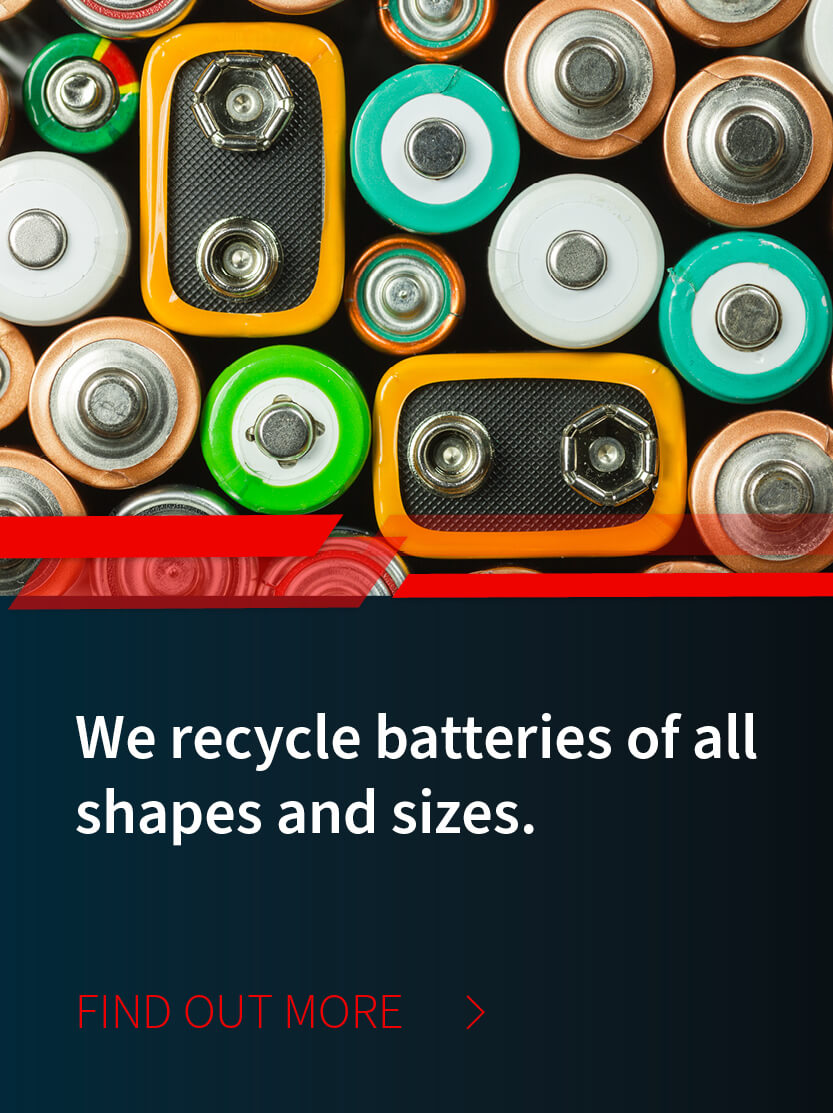
/ IN THIS BLOG
Beyond disposal, the requirements for packaging and transporting different types of batteries can be complex as well. Some batteries can simply be thrown in the trash, but others require more careful disposal or recycling. So, to help with this, we’re outlining some of the considerations to take when packaging, shipping, or disposing of batteries so you can better understand their special handling requirements.
01 / Batteries Without Disposal Restrictions
Alkaline batteries can be disposed of with your normal trash in most states. California is the one exception, as they are considered hazardous waste there. Additionally, the Environment Protection Agency (EPA) does recommend that people take these batteries to a recycling facility. Single-use batteries such as zinc-air, carbon-zinc, silver-oxide, and mercuric-oxide, along with other types of button batteries, can often be disposed of in the trash as well.
02 / Batteries With Packaging and Shipping Restrictions
Batteries are generally considered universal waste if they are classified as hazardous waste. These batteries typically include silver ion, lithium, and mercury. Nickel-cadmium batteries are also generally considered universal waste. Disposing of these batteries in landfills can cause soil contamination and water pollution. This is why they require special packaging and disposal. Here are some of the packaging and shipping requirements for some of the most common batteries classified as universal waste.
03 / Lithium Batteries
There are two common types of lithium batteries: lithium-ion and lithium metal. Lithium-ion batteries are rechargeable and used in electric automobiles and many types of electronics, such as cell phones, tablets, e-bikes, and laptops. Lithium metal batteries are typically not rechargeable and are found in products like cameras, watches, thermometers, and toys.
Packing
These batteries can be dangerous if they come into contact with water. They also can short-circuit if the terminals are not adequately protected. The batteries need to be packaged so as to prevent the terminals from touching each other. This can be done by putting on non-conductive caps, bagging them individually, placing non-conductive tape on them, or using the original packaging.
Shipping
The requirements for these batteries differ depending on whether your business is shipping a lithium-metal or lithium-ion battery, as well as whether or not the battery is being shipped alone or with other equipment or in other equipment. This affects the labeling or marking of the packages. Your shipment will likely also need to have documentation showing the type of battery as UN 3480, Lithium-Ion Battery, Class 9, PG II, or UN 3090, Lithium Metal Battery, Class 9, PG II.
The label needs to state that it must be handled with care due to the risk of fire should it be damaged. It should also state that special procedures need to be followed should the package be damaged. These include inspecting the package and repackaging it as needed. Additionally, your phone number should be included. The container you use must be marked with a Class 9 label with contrasting colors and a height of 6mm.
04 / Lead Acid Batteries
Lead acid batteries are commonly used in automobiles, toys, wheelchairs, scooters, and generators. Spent lead acid batteries are hazardous waste and, in most states, must be recycled.
Packing
There are special packing requirements when shipping the batteries to be recycled. The batteries must be stacked with their pole side out to make the stacks more stable. In addition to this, batteries of the same size must be stacked with shock-absorbing material between them. Also, batteries that are leaking should be shipped separately in leak-proof containers. It is also important to prevent batteries from short-circuiting during shipping.
Shipping
Batteries should be shipped in acid-resistant containers and carefully packed and tied down. There should be equipment on the truck or other mode of transportation for cleaning battery spills. Additionally, a route that does not travel through environmentally sensitive areas should be used. A hazard waste manifest or bill of lading is required when transporting an acid battery shipment. The shipping description should state that the batteries are UN 2800, Batteries, Wet, Non-Spillable, Class 8, PG III or UN 2794, Batteries, Wet, Containing Acid, 8, PG III. They should be labeled as Class 8,
05 / Dry Cell Nickel Cadmium Batteries
Nickel Cadmium batteries are often used in portable electronics and flashlights. These batteries must be recycled, and they do have special packing and shipping requirements.
Packing
Dry cell nickel-cadmium batteries that are higher than 9-volt must be packed so that the terminals do not touch each other. You can put conductive caps on them, bag them individually, place non-conductive tape on them, or use the original packaging.
Shipping
The Department of Transportation shipping description should be UN3028, Battery, Dry, Containing Potassium Hydroxide Solid, Class 8, PG II. The container you use should be labeled as Class 8, Corrosive. It must have a background with contrasting colors and a height of 6mm.
06 / Wet Cell Nickel Cadmium Batteries
Wet cell nickel cadmium batteries are often used in aviation for stand-by power and emergency lights, as well as in other situations where large capacities and high discharge rates are needed. They have certain packing and shipping requirements.
Packing
Wet cell nickel cadmium batteries should be packaged in a way that ensures the terminals will not touch each other by putting non-conductive caps on them, bagging them individually, placing non-conductive tape on them, or using the original packaging. If you will be shipping large wet cell Ni-Cad batteries, you will need to tape the terminals and place them in cubic yard boxes. Or, they can be fastened on skids that are at most two layers high and have plywood or cardboard placed between the batteries.
Shipping
The Department of Transportation shipping description should be “UN 2795, Battery, Wet, Filled with Alkaline, Class 8, PG III”. It must also have a Class 8 label with contrasting colors and a height of 6mm.
07 / Are You a Business that Needs Help with the Packaging, Shipping, and Disposal of Batteries?
Here we’ve outlined some of the basic requirements for packing and shipping batteries. However, it is essential to comply with all of the Department of Transportation requirements, which can be complicated. MCF Environmental Services can help you dispose of or recycle your batteries while complying with Department of Transportation requirements. If batteries are a big part of your business, it pays to do things right in every stage of battery handling. Trust the experts in management and disposal of hazardous contents. MCF Environmental is here to help you streamline the process and remain safe and compliant every step of the way. Contact our expert team to learn how we can help.
Robert Losurdo
President, COO








